
The Boeing 747 is a large, long-range wide-body airliner designed and manufactured by Boeing Commercial Airplanes in the United States between 1968 and 2023. After introducing the 707 in October 1958, Pan Am wanted a jet 2+1⁄2 times its size, to reduce its seat cost by 30%. In 1965, Joe Sutter left the 737 development program to design the 747. In April 1966, Pan Am ordered 25 Boeing 747-100 aircraft, and in late 1966, Pratt & Whitney agreed to develop the JT9D engine, a high-bypass turbofan. On September 30, 1968, the first 747 was rolled out of the custom-built Everett Plant, the world's largest building by volume. The 747's first flight took place on February 9, 1969, and the 747 was certified in December of that year. It entered service with Pan Am on January 22, 1970. The 747 was the first airplane called a "Jumbo Jet" as the first wide-body airliner.
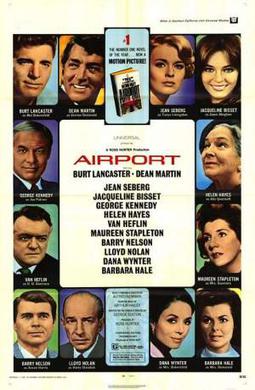
Airport is a 1970 American air disaster–drama film written and directed by George Seaton and starring Burt Lancaster and Dean Martin. Based on Arthur Hailey's 1968 novel of the same name, it originated the 1970s disaster film genre. It is also the first of four films in the Airport film series. Produced on a $10 million budget, it earned over $128 million. The supporting cast features Jean Seberg, Jacqueline Bisset, George Kennedy, Helen Hayes, Van Heflin, Maureen Stapleton, Barry Nelson, Lloyd Nolan, Dana Wynter and Barbara Hale.

A disaster film or disaster movie is a film genre that has an impending or ongoing disaster as its subject and primary plot device. Such disasters may include natural disasters, accidents, military/terrorist attacks or global catastrophes such as a pandemic. A subgenre of action films, these films usually feature some degree of build-up, the disaster itself, and sometimes the aftermath, usually from the point of view of specific individual characters or their families or portraying the survival tactics of different people.

Salt Lake City International Airport is a joint military/public airport located about 4 miles west of Downtown Salt Lake City, Utah, in the United States. The airport is the closest commercial airport for more than 2.5 million people and is within a 30-minute drive of nearly 1.3 million jobs. The airport serves as a hub for Delta Air Lines and is a major gateway to the Intermountain West and West Coast. The airport sees 343 scheduled nonstop airline departures per day to 93 cities in North America and Europe. It is by far the busiest airport in Utah.
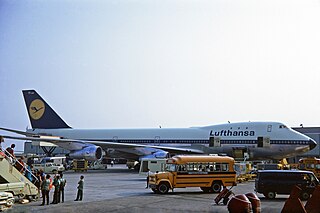
Lufthansa Flight 540 was a scheduled commercial flight for Lufthansa, serving the Frankfurt–Nairobi–Johannesburg route.
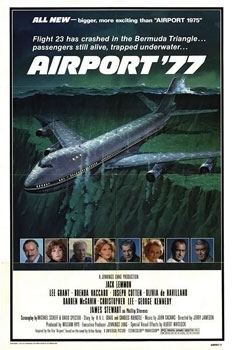
Airport '77 is a 1977 American air disaster film, and the third installment of the Airport film series. The film stars an ensemble cast of veteran actors including Jack Lemmon, James Stewart, Joseph Cotten, Olivia de Havilland, and Brenda Vaccaro as well as the return of George Kennedy from the two previous Airport films. It is directed by Jerry Jameson, produced by William Frye, executive produced by Jennings Lang with a screenplay by Michael Scheff and David Spector.
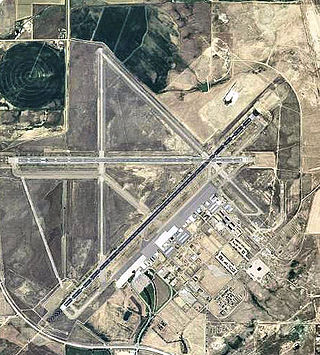
Casper–Natrona County International Airport is 7 miles (11 km) northwest of Casper, in Natrona County, Wyoming. Before December 19, 2007, the airport was called Natrona County International Airport.

Four Corners Regional Airport is in San Juan County, New Mexico, United States, in the city of Farmington, which owns it. It is a Class D towered general aviation airport with no commercial passenger services, but has chartered flight services, flight instruction, and a full service fixed base operator (FBO). It is included in the Federal Aviation Administration (FAA) National Plan of Integrated Airport Systems for 2019–2023, in which it is categorized as a regional general aviation facility.

The Beechcraft 1900 is a twin-engine turboprop regional airliner manufactured by Beechcraft. It is also used as a freight aircraft and corporate transport, and by several governmental and military organizations. With customers favoring larger regional jets, Raytheon ended production in October 2002.

Miracle Landing is a 1990 American made-for-television drama film based on an in-flight accident aboard Aloha Airlines Flight 243 that occurred in April 1988. The Boeing 737-200 was flying from Hilo, Hawaii to Honolulu, Hawaii, when it experienced rapid decompression when a section of the fuselage was torn away. With one flight attendant blown from the cabin to her death and 65 others injured, the aircraft was able to make a successful emergency landing at Kahului Airport, on Maui.

Durango–La Plata County Airport is a city- and county-owned public airport 12 miles southeast of Durango, in La Plata County, Colorado.

Canadian Forces Base Comox, commonly referred to as CFB Comox or 19 Wing, is a Canadian Forces Base located 2.5 nautical miles north northeast of Comox, Vancouver Island, British Columbia. It is primarily operated as an air force base by the Royal Canadian Air Force (RCAF) and is one of two bases in the country using the CP-140 Aurora anti-submarine/maritime patrol and surveillance aircraft. Its primary RCAF lodger unit is 19 Wing, commonly referred to as 19 Wing Comox.

The Concorde... Airport '79 is a 1979 American air disaster film and the fourth and final installment of the Airport franchise. Although poorly reviewed by critics and earning poorly in North America, the film was a huge hit internationally, for a total gross of $65 million on a $14 million budget.

Grand Canyon National Park Airport is a state-owned public-use airport located in Tusayan, CDP in unincorporated Coconino County, Arizona, United States. It is near Grand Canyon National Park, 1 mile from the South Rim entrance of the Grand Canyon. The airport is primarily used for scenic tours and charter flights.

Cascade Airways was an airline in the northwest United States which flew primarily regional air routes out of Seattle, Washington. Founded in 1969, it operated for 17 years and was shut down in 1986. Its IATA code (CZ) was later assigned to China Southern Airlines which was formed two years after Cascade's shutdown.

Canyonlands Regional Airport, Moab is a regional commercial airport in Grand County, Utah, United States, 21 miles (34 km) northwest of Moab. The airport services two airlines, one subsidized by the Essential Air Service program.
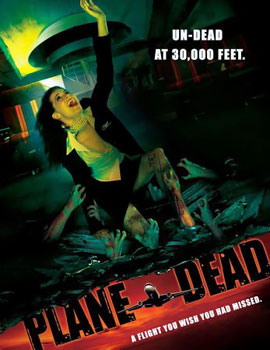
Flight of the Living Dead: Outbreak on a Plane is a 2007 direct-to-video zombie film by director Scott Thomas. Thomas co-wrote the screenplay with Mark Onspaugh and Sidney Iwanter. The film was originally titled Plane Dead, but the title was changed at Montreal's 2007 Fantasia Festival screening. In spite of a successful screening there and at other festivals, the film did not gain a commercial release and was issued directly to DVD in unrated form.

Northern Thunderbird Air Inc or NT Air is a Canadian charter airline and medevac service based in Prince George, British Columbia.

Sonic Impact is a 2000 action/thriller directed by Rodney McDonald and starring James Russo, Mel Harris, Michael Harris and Ice-T, with Michael Raynor.
Airport is a 1970s film series consisting of four airplane-themed disaster films: Airport, Airport 1975, Airport '77 and The Concorde... Airport '79. They are based on the 1968 novel Airport by Arthur Hailey. The four films grossed $387.5 million worldwide.


















